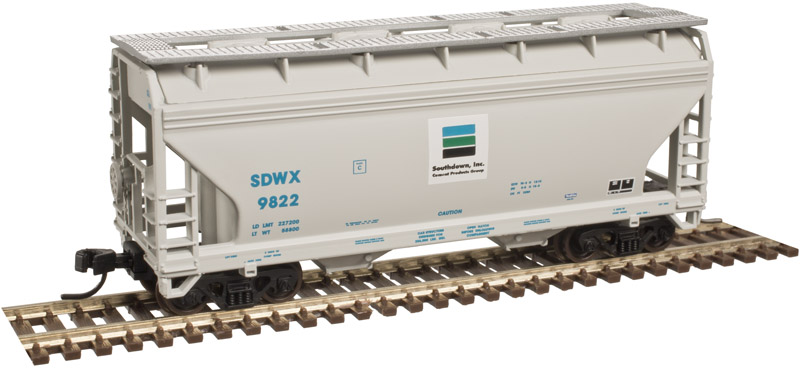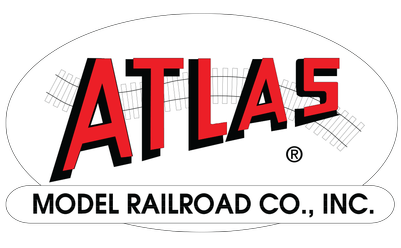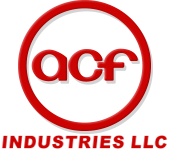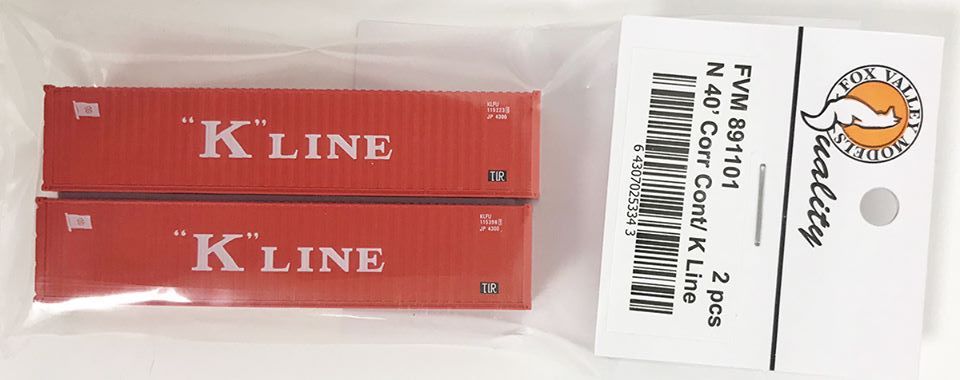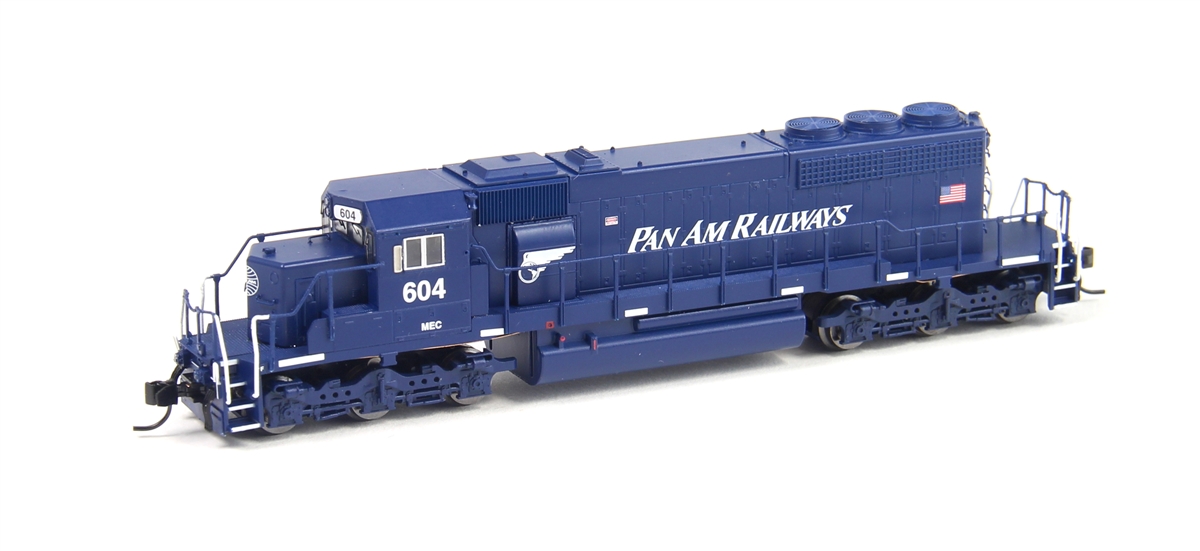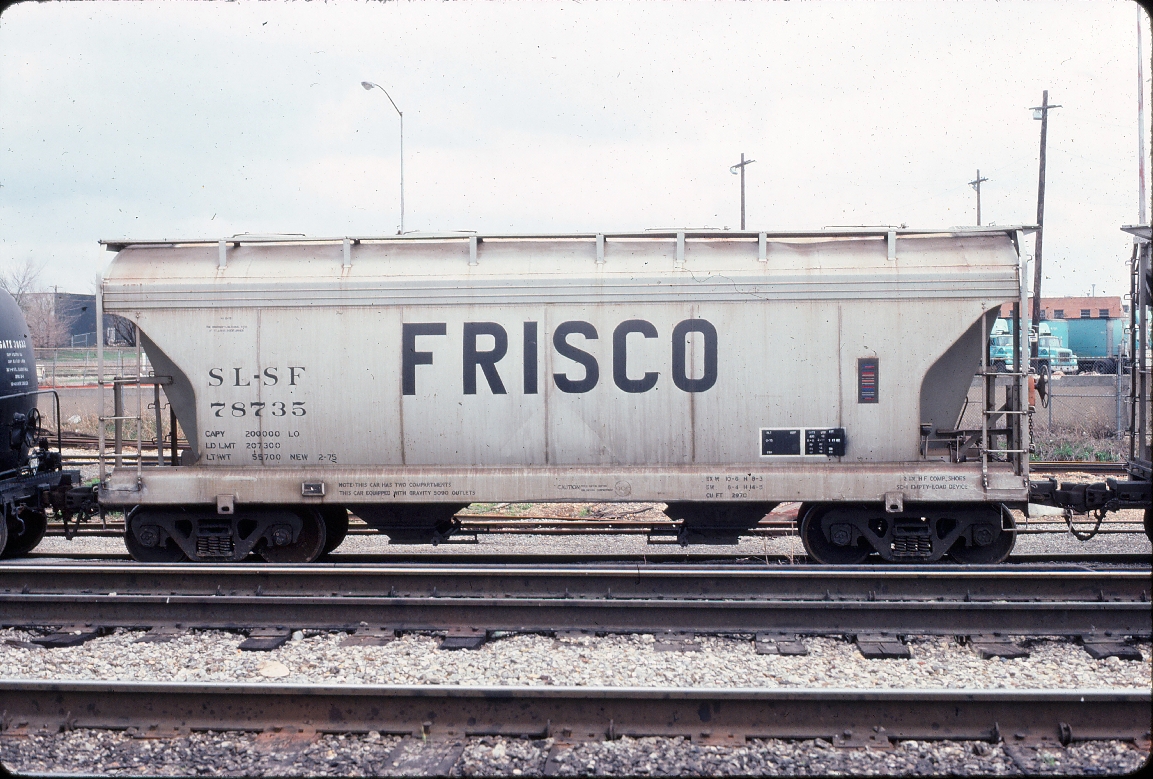Atlas - 50 003 610 - Covered Hopper, 2-Bay, ACF Centerflow - Southdown Cement - 9814
| Stock Number | 50 003 610 |
| Original Retail Price | $19.95 |
| Brand | Atlas |
| Manufacturer | Atlas |
| Body Style | Atlas Covered Hopper 2-Bay Centerflow |
| Image Provider's Website | Link |
| Prototype Vehicle | Covered Hopper, 2-Bay, ACF Centerflow (Details) |
| Road or Company Name | Southdown Cement (Details) |
| Reporting Marks | SDWX |
| Road or Reporting Number | 9814 |
| Paint Color(s) | Light Gray |
| Print Color(s) | Blue |
| Coupler Type | AccuMate Magnetic Knuckle |
| Wheel Type | Injection Molded Plastic |
| Wheel Profile | Small Flange (Low Profile) |
| Announcement Date | 2017-01-01 |
| Release Date | 2017-11-01 |
| Item Category | Rolling Stock (Freight) |
| Model Type | Covered Hopper |
| Model Subtype | 2-Bay |
| Model Variety | Center Flow |
| Prototype Region | North America |
| Prototype Era | NA Era IV: 2nd Gen Diesel (1958 - 1978) |
| Scale | 1/160 |
Model Information:
This body style first appears in Atlas' 1992 catalog with a pre-production photo and labeled "Coming in late '91". Seven road names were announced as well as a 3900 Undecorated model. The original release was made in Atlas' New Jersey facility and marked "Atlas USA" on the frame. Later production was moved to China and marketed under Atlas' Trainman® line.
Prototype History:
The 2-bay covered hopper first entered service in the 1950s. The cars handle loads such as cement, sand and similar denser bulk commodities. In the 1960s, American Car and Foundry introduced the Centerflow design. The Centerflow relies on the car's rounded body to provide structural strength without the added weight of bracing, as well as making gravity unloading easier. This 2-bay car came in a 2,970-cubic foot capacity.
The first ACF covered hoppers were rib-side cars, like many others of the time. In the 1960's ACF eliminated the supporting ribs and started building what they called the Center Flow(R) hopper with a smooth, rounded side. The cars were built at several ACF plants, but the Huntington, West Virginia plant built only Center Flow cars since their inception and was the primary builder.
The first ACF covered hoppers were rib-side cars, like many others of the time. In the 1960's ACF eliminated the supporting ribs and started building what they called the Center Flow(R) hopper with a smooth, rounded side. The cars were built at several ACF plants, but the Huntington, West Virginia plant built only Center Flow cars since their inception and was the primary builder.
Road Name History:
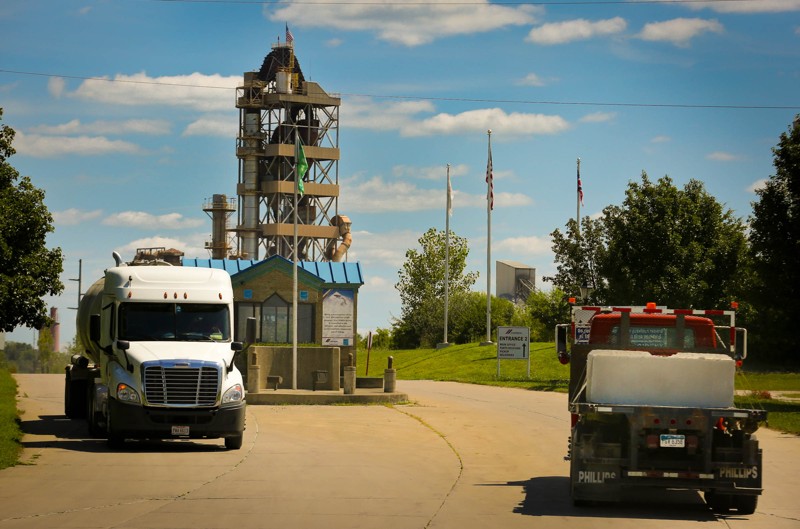 Southdown was a cement making company that was acquired in 2000 by Cemex. Southdown was based in Houston, TX. The acquisition at $2.6 billion represented the biggest-ever (at the time) acquisition by a Mexican company that would capture a prize U.S. asset in an industry that is consolidating globally.
Southdown was a cement making company that was acquired in 2000 by Cemex. Southdown was based in Houston, TX. The acquisition at $2.6 billion represented the biggest-ever (at the time) acquisition by a Mexican company that would capture a prize U.S. asset in an industry that is consolidating globally.
Southdown was one of the largest producers of cement and ready-mix concrete in the United States, Southdown, Inc. was also regarded as one of the industry's most efficient and modern producers. With eight manufacturing plants in California, Colorado, Florida, Kentucky, Ohio, Pennsylvania, Tennessee, and Texas, Southdown had distinguished itself as a leading competitor in an industry of vital importance to the construction industry, particularly large-scale public works projects. During the mid-1990s, more than half of the company's annual revenues and a substantially larger proportion of its operating earnings were generated from the production of cement, the primary binding agent in concrete. Southdown is also involved in the production of ready-mixed concrete, a building material used in myriad construction activities and the end-product of roughly 70 percent of the cement used in the United States. By gradually narrowing its focus on the production and marketing of these two products from the mid-1970s forward, Southdown established a solid position for itself in crucial cement and concrete markets across the country, particularly in Florida and southern California.
Southdown was founded as Realty Operators, Inc. in the spring of 1930, beginning its corporate life in Louisiana as a sugar cane grower during the incipient stages of the United States' greatest economic calamity. The company survived the decade-long ravages of the Great Depression, spending its formative years in the crucible of economic turmoil, then rallied forward through the United States' greatest military effort, withstanding the disruptive yet economically vibrant years of the Second World War. In 1948, three years after the conclusion of the war, Realty Operators changed its name to Southdown Sugars, Inc., borrowing the Southdown name from the Southdown sugar cane plantation in Houma, Louisiana. Over the course of the next 20 years, Southdown Sugars increased its stature as a sugar cane company, benefitting from the most advantageous economic conditions since its formation. The company changed its name again in 1959 to Southdown, Inc., prophetically dropping "Sugars" from its corporate title as it prepared to enter the 1960s, the last decade the company would rely exclusively on sugar cane cultivation and production to drive its growth.

Southdown was one of the largest producers of cement and ready-mix concrete in the United States, Southdown, Inc. was also regarded as one of the industry's most efficient and modern producers. With eight manufacturing plants in California, Colorado, Florida, Kentucky, Ohio, Pennsylvania, Tennessee, and Texas, Southdown had distinguished itself as a leading competitor in an industry of vital importance to the construction industry, particularly large-scale public works projects. During the mid-1990s, more than half of the company's annual revenues and a substantially larger proportion of its operating earnings were generated from the production of cement, the primary binding agent in concrete. Southdown is also involved in the production of ready-mixed concrete, a building material used in myriad construction activities and the end-product of roughly 70 percent of the cement used in the United States. By gradually narrowing its focus on the production and marketing of these two products from the mid-1970s forward, Southdown established a solid position for itself in crucial cement and concrete markets across the country, particularly in Florida and southern California.
Southdown was founded as Realty Operators, Inc. in the spring of 1930, beginning its corporate life in Louisiana as a sugar cane grower during the incipient stages of the United States' greatest economic calamity. The company survived the decade-long ravages of the Great Depression, spending its formative years in the crucible of economic turmoil, then rallied forward through the United States' greatest military effort, withstanding the disruptive yet economically vibrant years of the Second World War. In 1948, three years after the conclusion of the war, Realty Operators changed its name to Southdown Sugars, Inc., borrowing the Southdown name from the Southdown sugar cane plantation in Houma, Louisiana. Over the course of the next 20 years, Southdown Sugars increased its stature as a sugar cane company, benefitting from the most advantageous economic conditions since its formation. The company changed its name again in 1959 to Southdown, Inc., prophetically dropping "Sugars" from its corporate title as it prepared to enter the 1960s, the last decade the company would rely exclusively on sugar cane cultivation and production to drive its growth.
Brand/Importer Information:
In 1924 Stephan Schaffan, Sr. founded the Atlas Tool Company in Newark, New Jersey. In 1933 his son, Stephan Schaffan, Jr., came to work for his father at the age of sixteen. Steve Jr. built model airplanes as a hobby and frequented a local hobby shop. Being an enterprising young man, he would often ask the owner if there was anything he could do to earn some extra spending money. Tired of listening to his requests, the hobby-store owner threw some model railroad track parts his way and said, "Here, see if you can improve on this".
In those days, railroad modelers had to assemble and build everything from scratch. Steve Jr. created a "switch kit" which sold so well, that the entire family worked on them in the basement at night, while doing business as usual in the machine shop during the day.
Subsequently, Steve Jr. engineered the stapling of rail to fiber track, along with inventing the first practical rail joiner and pre-assembled turnouts and flexible track. All of these products, and more, helped to popularize model railroading and assisted in the creation of a mass-market hobby. The budding entrepreneur quickly outgrew the limitations of a basement and small garage operation. Realizing they could actually make a living selling track and related products, Steve and his father had the first factory built in Hillside, New Jersey at 413 Florence Avenue in 1947. On September 30, 1949, the Atlas Tool Company was officially incorporated as a New Jersey company.
In 1985, Steve was honored posthumously for his inventions by the Model Railroad Industry Association and was inducted into the Model Railroad Industry Hall of Fame in Baltimore, Maryland. In addition, Steve was nominated and entered into the National Model Railroad Association Pioneers of Model Railroading in 1995.
In the early 1990s, the Atlas Tool Company changed its name to Atlas Model Railroad Company, Inc.
In those days, railroad modelers had to assemble and build everything from scratch. Steve Jr. created a "switch kit" which sold so well, that the entire family worked on them in the basement at night, while doing business as usual in the machine shop during the day.
Subsequently, Steve Jr. engineered the stapling of rail to fiber track, along with inventing the first practical rail joiner and pre-assembled turnouts and flexible track. All of these products, and more, helped to popularize model railroading and assisted in the creation of a mass-market hobby. The budding entrepreneur quickly outgrew the limitations of a basement and small garage operation. Realizing they could actually make a living selling track and related products, Steve and his father had the first factory built in Hillside, New Jersey at 413 Florence Avenue in 1947. On September 30, 1949, the Atlas Tool Company was officially incorporated as a New Jersey company.
In 1985, Steve was honored posthumously for his inventions by the Model Railroad Industry Association and was inducted into the Model Railroad Industry Hall of Fame in Baltimore, Maryland. In addition, Steve was nominated and entered into the National Model Railroad Association Pioneers of Model Railroading in 1995.
In the early 1990s, the Atlas Tool Company changed its name to Atlas Model Railroad Company, Inc.
Item created by: gdm
on 2017-11-17 12:14:38
If you see errors or missing data in this entry, please feel free to log in and edit it. Anyone with a Gmail account can log in instantly.
If you see errors or missing data in this entry, please feel free to log in and edit it. Anyone with a Gmail account can log in instantly.


